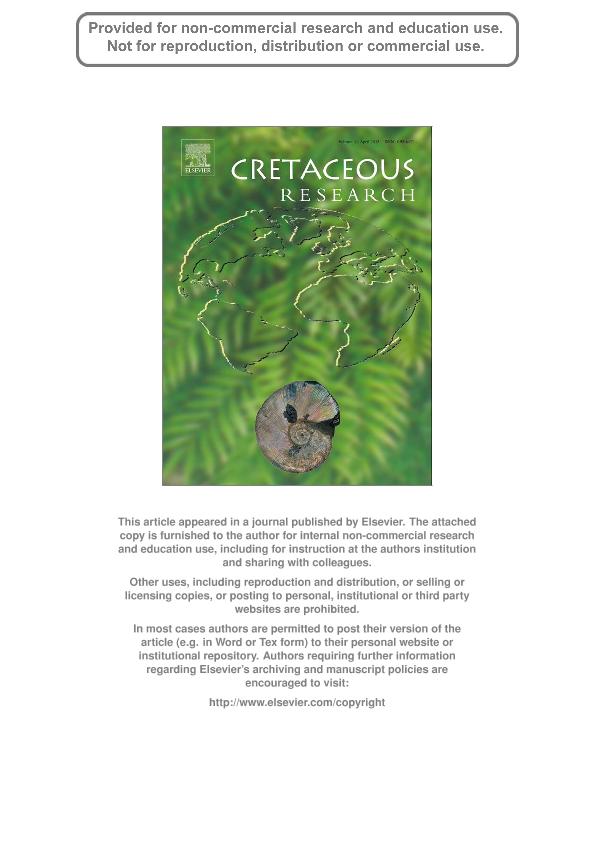Artículo
Palynofacies analysis and palynology of the Agua de la Mula Member (Agrio Formation) in a sequence stratigraphy framework, Lower Cretaceous, Neuquén Basin, Argentina
Guler, Maria Veronica ; Lazo, Dario Gustavo
; Lazo, Dario Gustavo ; Pazos, Pablo Jose
; Pazos, Pablo Jose ; Borel, Claudia Marcela
; Borel, Claudia Marcela ; Ottone, Eduardo Guillermo
; Ottone, Eduardo Guillermo ; Tyson, R; Cesaretti, Nora Noemi; Aguirre-Urreta, Maria Beatriz
; Tyson, R; Cesaretti, Nora Noemi; Aguirre-Urreta, Maria Beatriz
 ; Lazo, Dario Gustavo
; Lazo, Dario Gustavo ; Pazos, Pablo Jose
; Pazos, Pablo Jose ; Borel, Claudia Marcela
; Borel, Claudia Marcela ; Ottone, Eduardo Guillermo
; Ottone, Eduardo Guillermo ; Tyson, R; Cesaretti, Nora Noemi; Aguirre-Urreta, Maria Beatriz
; Tyson, R; Cesaretti, Nora Noemi; Aguirre-Urreta, Maria Beatriz
Fecha de publicación:
03/2013
Editorial:
Academic Press Ltd - Elsevier Science Ltd
Revista:
Cretaceous Research
ISSN:
0195-6671
Idioma:
Inglés
Tipo de recurso:
Artículo publicado
Clasificación temática:
Resumen
Variations in the sedimentary organic matter were documented throughout the Agua de la Mula Member (late Hauterivian) of the Agrio Formation, at a combined section in the type area of the Agrio Formation;the base at Agrio del Medio and the middle to top at Bajada del Agrio. A main organic-rich interval wasidentified in the basal Agua de la Mula Member, dominated by marine-derived Amorphous Organic Matter (AOM), coinciding with the highest Total Organic Carbon (TOC) content, between 1.4 and 3.8 wt.%,suggesting dysoxic conditions. The rest of the Member is predominantly characterized by terrestriallyderived organic matter, mainly phytoclasts, with low TOC values, around 1% or lower, indicating predominantly oxic depositional settings. By integrating stacking pattern and shell beds analysis, four depositional sequences SQ1eSQ4 were recognized. The organic-rich, finely laminated bituminous black shales of the Spitidiscus riccardii zone constitute a mayor and rapid inundation defining a Transgressive System tract (TST), related to a third order asymmetrical mesosequence dominated by a thick High System Tract (HST). It represents the most widespread and important flooding episode within the Neuquén Basin during the late Hauterivian. Inside sequences of higher frequency (SQ1, SQ2, SQ3, SQ4) of probably fourth order were recognized and analysed including several ammonids zones (Spitidiscus riccardii, Crioceratites schlagintweiti, C. diamantensis and Paraspiticeras groeberi). With the exception of the oxygen-controlled, basinal and outer ramp settings indicated for the TST1, which is equivalent to the TST of a lower order sequence, and the lower TST2, respectively, the prevalence of well oxygenated, inner to middle ramp depositional environments, is suggested for the rest of the sedimentary succession and emphasized in HST of SQ2, SQ3 and SQ4. Thus, a shallowing-upward trend with improved oxygenation is recorded through the Agua de la Mula Member, reflected by decreasing TOC, AOM content and preservation state of the organic matter. Based on the whole rock fluorescence analysis of the two selected organic-rich intervals from the Spitidiscus riccardii and the lowermost Crioceratites diamantensis zones,the presence of hydrocarbons suggests a very early in situ generation.
Palabras clave:
PALYNOFACIES
,
AGRIO FORMATION
,
NEUQUEN BASIN
,
ARGENTINA
Archivos asociados
Licencia
Identificadores
Colecciones
Articulos(IDEAN)
Articulos de INSTITUTO DE ESTUDIOS ANDINOS "DON PABLO GROEBER"
Articulos de INSTITUTO DE ESTUDIOS ANDINOS "DON PABLO GROEBER"
Articulos(INGEOSUR)
Articulos de INST.GEOLOGICO DEL SUR
Articulos de INST.GEOLOGICO DEL SUR
Citación
Guler, Maria Veronica; Lazo, Dario Gustavo; Pazos, Pablo Jose; Borel, Claudia Marcela; Ottone, Eduardo Guillermo; et al.; Palynofacies analysis and palynology of the Agua de la Mula Member (Agrio Formation) in a sequence stratigraphy framework, Lower Cretaceous, Neuquén Basin, Argentina; Academic Press Ltd - Elsevier Science Ltd; Cretaceous Research; 41; 3-2013; 65-81
Compartir
Altmétricas



